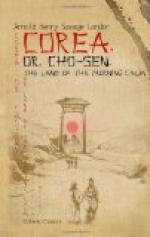The phoenix is also occasionally to be seen standing on a tortoise’s back, the combination being emblematic of the combined virtues of these two mythical creatures.
Returning to the main street, we can walk a long way without finding anything interesting in the way of architecture, or of a monumental character until we reach the East Gate, which is probably the largest gate of all. One of the peculiarities of this gate is that on the outside it has a semi-circular wall protection, and in this wall a second gate which renders it, therefore, doubly strong in time of war. The outer wall is very thick, and a wide space is provided which can be manned with soldiers, when the town happens to be besieged. If my memory serves me rightly, yet another gate in Seoul is provided with a similar contraffort, but of this I am not quite certain, for the part of my diary in which the wall of Seoul is described has been, I regret to say, unfortunately mislaid. Near the gate above mentioned, is a large open space, on the centre of which stands a somewhat dilapidated pavilion pour facon de parler, and, on inquiry, I was told that this place was the drilling-ground of the king’s troops, the pavilion being for the use of the king and high officials, when on very grand occasions they went to review the soldiery. Of late years, I believe, a new drilling-ground has been selected by the foreign military instructors, which explains why the pavilion has been allowed to rot and tumble down. (See Illustration p. 90.)
As already remarked, all the gates of Seoul, as well as those of every other city in Corea, are closed at sunset; but, like all rules, this one, too, has its exception. Thus, there is a small gate, called the “Gate of the Dead,” which is opened till a late hour at night. Its name explains its object fairly well, but for the benefit of those who are unaccustomed to Corean customs I may as well put the matter a little clearer. Funerals, in Corea, nearly always take place at night, and the bodies are invariably carried out of the town to be buried. In lifetime it is permitted to enter or leave the town through any gate you please, but this freedom of choice is not accorded to the dead, when their final exit is to be made, for this is only by way of the smaller gate just mentioned.




